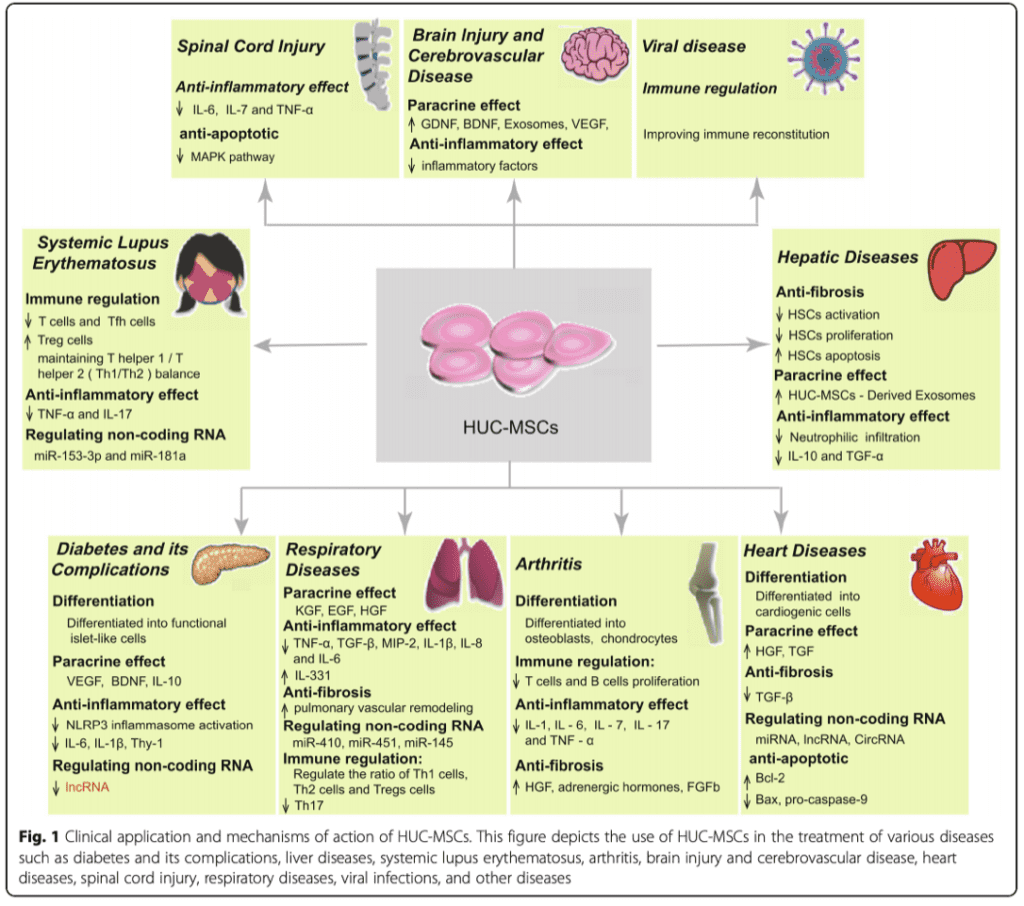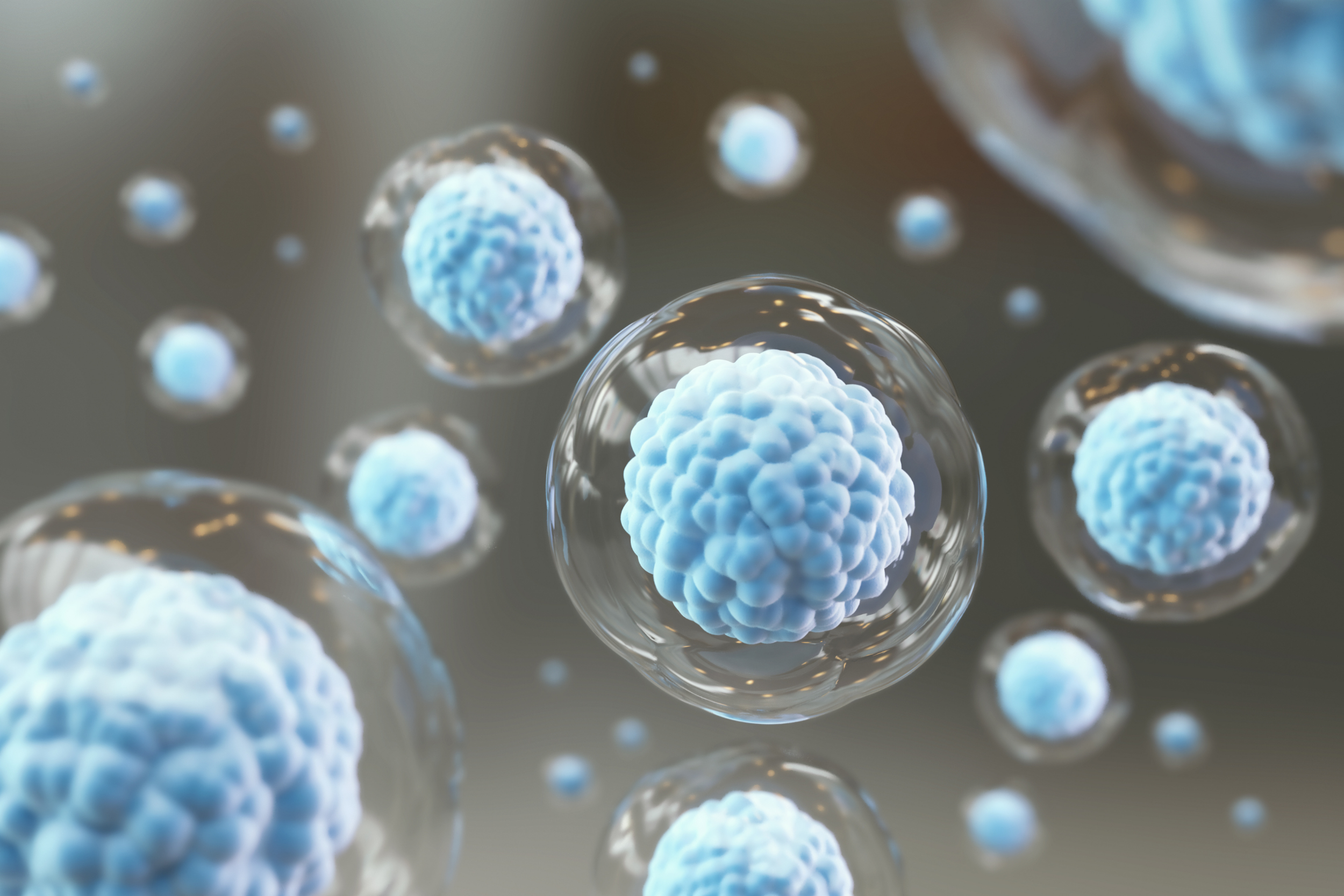Possibly one of the most effective forms of medicine to date has been discarded as waste for a long time. For decades now scientists and clinicians have been researching the potential for human umbilical cord mesenchymal stem cells (HUC-MSC) as a tool for treating multiple conditions. These cells have the ability to self-renew and under certain conditions can transform into different types of cells that make up our tissues and organs.
HUC-MSCs, often referred to as MSCs for short, are powerful master healers in our body, with super-hero-like abilities of anti-inflammation and regeneration. Another huge perk for these medicine marvels is they can be harvested very simply and have low immunogenicity (meaning they have a very, very low chance of provoking your immune to respond badly). Let’s look at some of the areas MSC therapy has been successful in improving.
First off let’s talk about how these clever cells do such a remarkable job at essentially all-things healing. They have several distinct effects that make them essential for therapeutic applications:
- Differentiation: Promote tissue regeneration and improves tissue function.
- Immune regulation: Inhibit the auto-inflammatory state of immune cells and turn macrophages from pro-inflammatory phenotypes to anti-inflammatory phenotypes.
- Reduce inflammation by secreting interleukin-10 (IL-10) and interleukin-4 (IL-4). This means speeding up tissue repair.
- Paracrine effects: MSCs promote tissue regeneration by secreting soluble molecules such as exosomes, various growth factors, and other cytokines. If you don’t remember these from biology class, these are basically some of our key proteins doing all the work behind-the-scenes in our body.
- Anti-inflammatory effect: Have we mentioned how good they are and helping with inflammation! MSCs suppress the secretion of inflammatory factor interleukin-1β (IL-1β), tumor necrosis factor-α (TNF-α), and interleukin-8 (IL-8), reducing inflammation and oxidative stress, thus suppressing cell apoptosis (death).
- Support Role: Mesenchymal cells have been reported to act as supporting cells that promote the expansion of other stem cell types. So not only do they provide the brunt of the work, but they also help out their neighbors.
- Anti-fibrotic activity: MSCs stimulate fibrosis-related cell apoptosis and the secretion of HGF and other molecules. Essentially, they help get rid of scar tissue that may be making our arteries, heart, lungs, liver, and other tissues function poorly.
- Other fancy stuff: Like non-coding RNA regulation. MSCs can affect the expression of microRNA (miRNA), long non-coding (lncRNA), and circular RNA (circRNA), indirectly regulating their target genes and achieving therapeutic effects.
- Tissue Engineering: On top of all these organic effects they have, they can also be engineered in a lab. They have the potential to be turned into various cell types, such as bone or cartilage. Procedures such as joint replacements may one day be a thing of the past (Xie et al 2020).
You’re probably getting the picture by now. HUC-MSCs have a lot of tools for healing. I get asked often what conditions umbilical cord stem cells can work for. As of now, there are dozens that the same medicine, UC-MSCs, can be applied to. Below is a nice illustration of some of the clinical applications and how MSCs work for each condition.

We’ve treated almost all of the conditions from the above picture, plus more. One of our most common successes has been in treating Autism. We’ve performed hundreds of orthopedic procedures on joints such as knees, shoulder, backs, and others.
Diabetes
In diabetic animals, HUC-MSCs have been shown to migrate to sites in the pancreas and change into functional pancreas cells. The MSCs also block the activation of inflammation in the pancreas. . Over the course of time, diabetes improves. In diabetic patients, it typically takes 6 months to 1 year to see improvements in insulin and C-peptides, as well as decreases in fasting glucose, hA1C, and the amount of daily insulin needed decreases. HUC-MSC treatments have even shown promising results in improving kidney and eye function in diabetics with complications.
Arthritis
HUC-MSCs have the ability to protect bone and cartilage, making them an effective treatment for arthritis. Not only can they help build lost bone and cartilage, but they can significantly weaken the progress of osteoarthritis (OA). OA, the most common type of arthritis, is where the protective layers of cartilage in a joint is breaking down faster than the body can repair it. Repeated studies have found improvement in OA assessments, such as the WOMAC, VAS, and Lequesne scores. These tests measure how severely one has OA. One fascinating study by Kim et al, saw continued cartilage growth 2 years after MSC treatments after follow-up MR
Respiratory Diseases
As noted by HUC-MSC researcher Qixin Xie, “HUC-MSCs have been used in the treatment of lung diseases for more than 10 years. HUC-MSCs protect lung tissue primarily through anti-inflammatory and anti-fibrotic activity, immune regulation, and paracrine mechanisms. HUC-MSCs also indirectly treat lung diseases by regulating the expression of microRNAs. In short, these cells provide an important therapeutic effect and have a wide range of applications in the treatment of respiratory diseases.” Respiratory disease patients see significantly elevated functional scores and increased survival after HUC-MSC treatments.
HUC-MSCs improve lung function by:
- Reduction of airway inflammation; inhibition of the secretion of inflammatory factors such as IL-1β, TNF-α, TGF-β, IL-6, and IL-8; inhibition of the oxidative stress caused by inflammation; and anti-apoptotic signaling; (2)
- Promotion of the secretion of growth factors, such as KGF, stem cell growth factor, HGF, and EGF; activation of tissue repair; and enhancement of lung perfusion;
- Remodeling of pulmonary vasculature and improvement of lung function; and
- Regulation of lung function through the expression of miR-410, miR-451, and miR-145
Hearing patients say they could go for a walk, or go shopping, or play with their grandkids for the first time without needing a scooter or to stop for oxygen is very inspiring.
Hopefully, this gives you some idea of the potentials this amazing medicine holds. Future research will see HUC-MSCs being used for longevity research, significantly increasing our lifespan and how we age. There’s already research being done in aging populations. A randomized, double-blinded, dose-finding study in elderly, frail individuals showed that intravenously delivered allogeneic MSCs are safe and produce significant improvements in physical performance measures and inflammatory biomarkers. Furthermore, to gain these results a dose of only 100-200 million MSCs was used.
-Dr. Travis Whitney
To find out if HUC-MSC therapy is right for you or a loved one contact the Innate Healthcare Institute.
Innate Healthcare Institute
4840 E. Indian School Rd #104
Phoenix, AZ 85018
602.603.3118
info@innateheal1stg.wpenginepowered.com
References:
Cai, Jinquan, et al. “Umbilical Cord Mesenchymal Stromal Cell With Autologous Bone Marrow Cell Transplantation in Established Type 1 Diabetes: A Pilot Randomized Controlled Open-Label Clinical Study to Assess Safety and Impact on Insulin Secretion.” Diabetes Care, vol. 39, no. 1, 2015, pp. 149–157., doi:10.2337/dc15-0171.
Kong, Dexiao, et al. “Umbilical Cord Mesenchymal Stem Cell Transfusion Ameliorated Hyperglycemia in Patients with Type 2 Diabetes Mellitus.” Clinical Laboratory, vol. 60, no. 12/2014, 2014, doi:10.7754/clin.lab.2014.140305.
Oppliger, Byron, et al. “Intranasal Delivery of Umbilical Cord-Derived Mesenchymal Stem Cells Preserves Myelination in Perinatal Brain Damage.” Stem Cells and Development, vol. 25, no. 16, 2016, pp. 1234–1242., doi:10.1089/scd.2016.0027.
Schulman, Ivonne Hernandez, et al. “Mesenchymal Stem Cell Therapy for Aging Frailty.” Frontiers in Nutrition, vol. 5, 2018, doi:10.3389/fnut.2018.00108.
Sun, Xiaoya, et al. “Human Umbilical Cord-Derived Mesenchymal Stem Cells Ameliorate Insulin Resistance by Suppressing NLRP3 Inflammasome-Mediated Inflammation in Type 2 Diabetes Rats.” Stem Cell Research & Therapy, vol. 8, no. 1, 2017, doi:10.1186/s13287-017-0668-1.
Thomi, et al. “Intranasally Administered Exosomes from Umbilical Cord Stem Cells Have Preventive Neuroprotective Effects and Contribute to Functional Recovery after Perinatal Brain Injury.” Cells, vol. 8, no. 8, 2019, p. 855., doi:10.3390/cells8080855.
Xiang, E, et al. “Human Umbilical Cord-Derived Mesenchymal Stem Cells Prevent the Progression of Early Diabetic Nephropathy through Inhibiting Inflammation and Fibrosis.” Stem Cell Research & Therapy, vol. 11, no. 1, 2020, doi:10.1186/s13287-020-01852-y.
Xie, Qixin, et al. “What Is the Impact of Human Umbilical Cord Mesenchymal Stem Cell Transplantation on Clinical Treatment?” Stem Cell Research & Therapy, vol. 11, no. 1, 2020, doi:10.1186/s13287-020-02011-z.
Yin, Yaqi, et al. “The Homing of Human Umbilical Cord-Derived Mesenchymal Stem Cells and the Subsequent Modulation of Macrophage Polarization in Type 2 Diabetic Mice.” International Immunopharmacology, vol. 60, 2018, pp. 235–245., doi:10.1016/j.intimp.2018.04.051.




